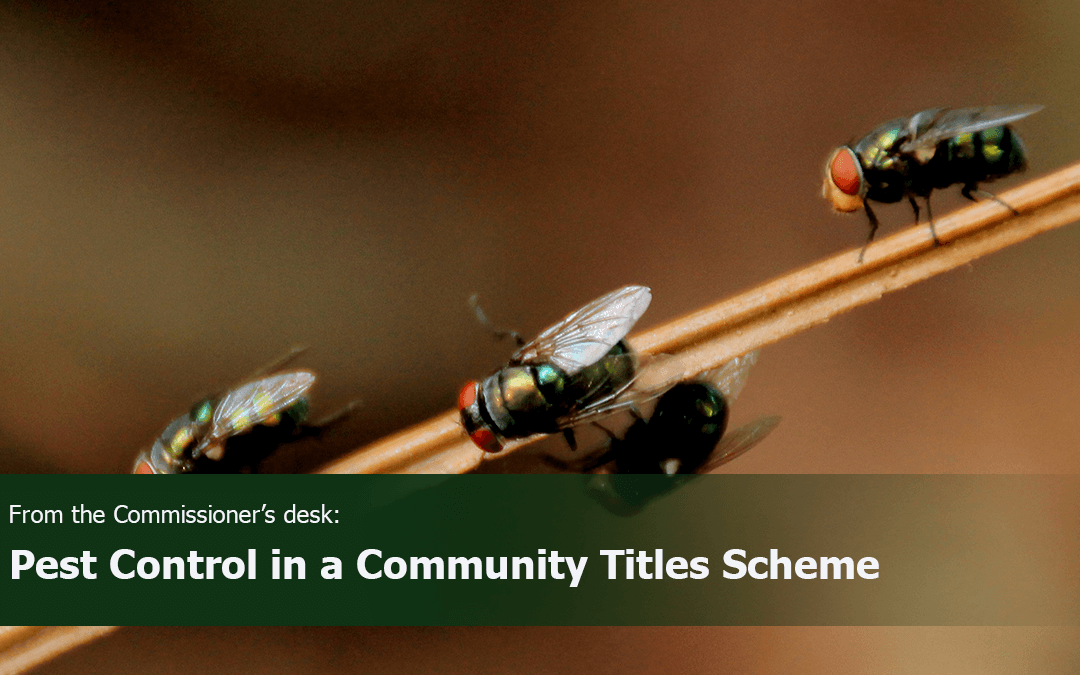A common enquiry for our Office is about the responsibility for pest control, particularly in relation to termites.
This is not surprising, given the amount of damage a pest can cause. There have also been adjudication orders regarding pest control. As always, this information is not meant to be legal advice and our Office certainly has no expertise in pest control—please seek qualified advice as necessary.
Who’s responsible for preventing pests?
Working out who is responsible for pest prevention in a community titles scheme can sometimes be tricky. An adjudicator considered the issue in Pannorama [2011] QBCCMCmr 461, as it related to termites:
Owners are normally responsible for their own termite management when schemes are registered under a standard format plan, and the body corporate is normally responsible for termite management when schemes are registered under a building format plan.
However, the division of legislative responsibilities … mean[s] the individual configuration of schemes can affect this.
The division of legislative responsibilities that the adjudicator refers to are as follows:
- an owner’s duties to maintain the following things in good condition:
- their lot
- any areas of common property over which their lot has exclusive use rights, excluding
- common property utility infrastructure (e.g. plumbing and electrical wiring), and
- any other things that the by-law establishing the exclusive use area identifies as the body corporate’s responsibility.
- The body corporate’s duties include to maintain the following things in good condition:
- common property
- the following elements of building format plan lots:
- railings, parapets and balustrades on (or for all intents and purposes on) the boundary of a lot and common property
- doors, windows and associated fittings in a boundary wall separating a lot from common property
- roofing membranes that provide protection for lots or common property
The body corporate must also maintain the following elements of building format plan lots in a structurally sound condition:
- foundation structures
- roofing structures providing protection
- essential supporting framework, including load-bearing walls.
According to the adjudicator in Tea Tree Grove At Hendra [2010] QBCCMCmr 518, maintenance responsibilities extend beyond the rectification of damage, to include work that may be reasonably expected to minimise the need for future maintenance. Therefore, it includes a responsibility for reasonable pest prevention, as well as rectification of any damage caused by pests.
Who’s responsible for fixing damage caused by pests?
As you’ve seen, it can be difficult to work out who’s responsible for maintaining things that pests might damage, let alone who’s responsible for rectifying any damage caused by pests. Having said this, there are generally only three alternatives.
- The party with the maintenance responsibility
The party that is responsible for the maintenance of the part of scheme land that has been damaged will generally be responsible for fixing it, where:
- they could have prevented the damage by doing reasonable maintenance
- no reasonable maintenance could have prevented the damage
- reasonable maintenance was done by everyone with a responsibility to do it, but the damage occurred anyway
- no-one else will repair the damage and it needs to be repaired to fulfil their maintenance responsibility.
(Note: this does not stop them pursuing another party for all or part of the costs.)
- Another party
Another party may be held responsible for fixing damage caused by pests, where:
- they failed to do something that they had a legal responsibility to do, and that failure directly caused the damage (e.g. an owner failed to take reasonable steps to maintain a tree on their lot, and termites from that tree ended up damaging common property—see: Tea Tree Grove At Hendra [2010] QBCCMCmr 518).
- they intentionally did something that caused the damage (e.g. encouraging pigeons to roost in common areas by continually feeding them—see: Mosman Court [2005] QBCCMCmr 393).
- More than one party
Where multiple parties have contributed to the damage caused—whether by failing to do something they had a responsibility to do, or by intentionally doing something—those parties may all be held responsible for fixing it. The proportion of their responsibility should be calculated by referring to the extent to which their actions caused the damage.
As an example, in Regency Place Lakeside [2002] QBCCMCmr 702, the adjudicator noted that:
An owner might be considered to have contributed to termite damage if [they] fail … to notify the body corporate of evidence of internal termite infestation. In the case of a non-resident owner, this requires that [they] ensure that internal inspections of the lot are undertaken on a regular basis … If there was evidence of termite damage to a lot over a sustained period of time which was not reported to the body corporate, I would have no hesitation in finding a form of contributory negligence on the part of the owner of [that] lot, and determining compensation accordingly.
These orders provide guidance, but it is important to remember that each case is different and depends on its merits. You might also like to consult the Queensland Building and Construction Commission for some further information.
For further information please contact the Information and Community Engagement Unit of my Office on 1800 060 119 or visit our website www.qld.gov.au/bodycorporate.
